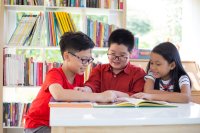Problem-Solving in Elementary School
Elementary students practice problem-solving and self-questioning techniques to improve reading and social and emotional learning skills.
Your content has been saved!
Go to My Saved Content.In a school district in New Jersey, beginning in kindergarten each child is seen as a future problem solver with creative ideas that can help the world. Vince Caputo, superintendent of the Metuchen School District, explained that what drew him to the position was “a shared value for whole child education.”
Caputo’s first hire as superintendent was Rick Cohen, who works as both the district’s K–12 director of curriculum and principal of Moss Elementary School. Cohen is committed to integrating social and emotional learning (SEL) into academic curriculum and instruction by linking cognitive processes and guided self-talk.
Cohen’s first focus was kindergarten students. “I recommended Moss teachers teach just one problem-solving process to our 6-year-olds across all academic content areas and challenge students to use the same process for social problem-solving,” he explained.
Reading and Social Problem-Solving
Moss Elementary classrooms use a specific process to develop problem-solving skills focused on tending to social and interpersonal relationships. The process also concentrates on building reading skills—specifically, decoding and comprehension.
Stop, Look, and Think. Students define the problem. As they read, they look at the pictures and text for clues, searching for information and asking, “What is important and what is not?” Social problem-solving aspect: Students look for signs of feelings in others’ faces, postures, and tone of voice.
Gather Information. Next, students explore what feelings they’re having and what feelings others may be having. As they read, they look at the beginning sound of a word and ask, “What else sounds like this?” Social problem-solving aspect: Students reflect on questions such as, “What word or words describe the feeling you see or hear in others? What word describes your feeling? How do you know, and how sure are you?”
Brainstorming. Then students seek different solutions. As they read, they wonder, “Does it sound right? Does it make sense? How else could it sound to make more sense? What other sounds do those letters make?” Social problem-solving aspect: Students reflect on questions such as, “How can you solve the problem or make the situation better? What else can you think of? What else can you try? What other ideas do you have?”
Pick the Best One. Next, students evaluate the solution. While reading, they scan for smaller words they know within larger, more difficult words. They read the difficult words the way they think they sound while asking, “Will it make sense to other people?” Social problem-solving aspect: Students reflect on prompts such as, “Pick the solution that you think will be best to solve the problem. Ask yourself, ‘What will happen if I do this—for me, and for others involved?’”
Go. In the next step, students make a plan and act. They do this by rereading the text. Social problem-solving aspect: Students are asked to try out what they will say and how they will say it. They’re asked to pick a good time to do this, when they’re willing to try it.
Check. Finally, students reflect and revise. After they have read, they ponder what exactly was challenging about what they read and, based on this, decide what to do next. Social problem-solving aspect: Students reflect on questions such as, “How did it work out? Did you solve the problem? How did others feel about what happened? What did you learn? What would you do if the same thing happened again?”
You can watch the Moss Elementary Problem Solvers video and see aspects of this process in action.
The Process of Self-Questioning
Moss Elementary students and other students in the district are also taught structured self-questioning. Cohen notes, “We realized that many of our elementary students would struggle to generalize the same steps and thinking skills they previously used to figure out an unknown word in a text or resolve social conflicts to think through complex inquiries and research projects.” The solution? Teach students how to self-question, knowing they can also apply this effective strategy across contexts. The self-questioning process students use looks like this:
Stop and Think. “What’s the question?”
Gather Information. “How do I gather information? What are different sides of the issue?”
Brainstorm and Choose. “How do I select, organize, and choose the information? What are some ways to solve the problem? What’s the best choice?”
Plan and Try. “What does the plan look like? When and how can it happen? Who needs to be involved?”
Check & Revise. “How can I present the information? What did I do well? How can I improve?”
The Benefits
Since using the problem-solving and self-questioning processes, the students at Moss Elementary have had growth in their scores for the last two years on the fifth-grade English language arts PARCC tests. However, as Cohen shares, “More important than preparing our students for the tests on state standards, there is evidence that we are also preparing them for the tests of life.”
